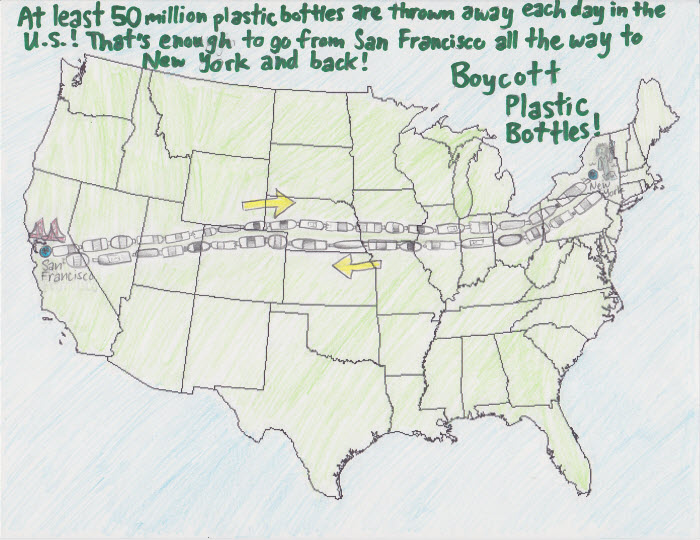I spoke at a conference recently where over 800 members of the audience received plastic bottles of water. The intention, I imagine, was to send a healthful message. But it didn’t feel right and I began wondering: Where do all these bottles go? So I researched the subject and learned some interesting facts:
- Americans use approximately 70 million plastic water bottles each day and throw away (not recycle) around 50 million of them. End-to-end, these would reach from New York to San Francisco and back again.
- Roughly 50 billion plastic water bottles end up in U.S. landfills each year. That’s enough, laid end to end, to reach China and back.
- We are shipping 1 billion water bottles a week around the U.S. in ships, trains, and trucks.
- Disposable plastic water bottles are made out of oil which is a finite natural resource.
- It costs 2 to 4 times the cost of gasoline to supply the equivalent amount of water.
- Plastic bottles require energy to make and transport. Currently, the amount of oil we use to produce water bottles each year (17 million barrels) could fuel over 1,000,000 cars for an entire year.
- The environmental impact of one disposable bottle: Picture a disposable water bottle ¼ full of petroleum. That is how much petroleum it takes to make and distribute a single plastic bottle of water; It takes THREE bottles of water to make and distribute ONE disposable plastic bottle of water.
- 120 grams of greenhouse gases are generated by a single disposable plastic bottle of water.
- It takes 700 years for plastic to decompose:
- Plastic pollution is a world-wide problem. There is a growing “garbage patch” of plastic, estimated to be more than twice the size of the United States, floating in the North Pacific Ocean, and another in the North Atlantic.
- Ecosystems and wildlife are negatively impacted by plastic debris.
If you are running a conference, or if you are a trainer, facilitator or consultant, or if you run meetings in your organization, think about the message you are sending to your audience if you use plastic (PET) water bottles. Consider filling a reusable water bottle yourself, and inviting your audience, or your colleagues, to do the same. After all, research shows that the water in branded water bottles is often city tap water anyway!
In so doing, you will be modeling behavior that makes an inspiring statement to your colleagues, by showing that the future of the planet is important to you.


Thank you for your thoughtful post. I agree completely with what you’ve written.
BUT…I’d love to see you advocate for an alternative solution that doesn’t involve just going to the tap to refill a glass or bottle.
As one recent news story about a region unable to drink or even cook or wash with their water indicates, we’re on the brink of doing terrible things to our water supply. Fracking, I believe, is one clear danger in that regard.
Maybe someone could develop a less destructive way of delivering clean water from ‘afar’, while others wrap their heads around the concept of protecting the water sources upon which we depend.
Good point. But there are many ways of looking this. For example, if we invested in our public transportation systems like the Europeans are, and continued to do, (https://www.globalrailnews.com/2014/01/02/velaro-d-certified-to-operate-in-germany/) and like San Francisco is (https://www.finanznachrichten.de/nachrichten-2014-01/29052800-bombardier-wins-additional-order-from-san-francisco-bart-number-of-new-rail-cars-on-order-rises-to-775-fleet-of-the-future-to-offer-highest-256.htm) our need for energy would decline, and the attractiveness of fracking would diminish also. Furthermore, the jury is still out about the dangers of tracking. The research and the scientific opinions vary, depending on which report you read.